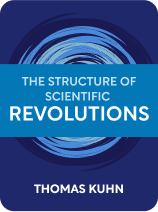

This article is an excerpt from the Shortform book guide to "The Structure Of Scientific Revolutions" by Thomas Kuhn. Shortform has the world's best summaries and analyses of books you should be reading.
Like this article? Sign up for a free trial here .
What is scientific progress? Why is there a lack of consensus on what constitutes progress in science?
The definition of scientific progress is not a simple one. According to Thomas Kuhn, what is deemed progress in normal science is different from progress in revolutionary science. To fully resolve this contradiction, we must give up the idea that science is linear and has a clear endpoint.
Keep reading to learn more about scientific progress: the nature of it, why it’s expected, and how it happens.
What Is Scientific Progress?
There are several conceptions as to what constitutes scientific progress. The original conception is that scientific progress occurs when science gets closer to the truth or increases in the degree of verisimilitude or truth-likeness. However, this conception was condemned by Thomas Kuhn and othes in 1960s.
According to Kuhn, “scientific progress” is often a label put on events by their observers. The reason normal science seems to progress is clear: Scientists working within a paradigm have a clear set of problems to solve, and the means by which to solve them.
Normal science benefits from being fairly well insulated from the laypeople. Scientists generally only show their work to other scientists, meaning they can take certain beliefs and rules for granted. Furthermore, the scientists can choose problems they are reasonably confident they’ll be able to solve, without worrying about what needs to be solved, as an engineer or doctor might have to. All of this makes progress both faster and clearer than in other professions.
Scientific Progress as a Revolution
Interestingly, revolutionary science—in the sense of a paradigm shift—is also seen as scientific progress, even though it doesn’t use accepted methods to solve accepted problems. In large part, this may be because revolutions must end in victory for one side or the other, and it’s unlikely that the winning side will see its victory as anything but progress.
That school’s paradigm is then written into textbooks and other educational materials, and it becomes what the next generation of scientists believes as well. Therefore, a revolution being seen as scientific progress after the fact is practically a given. (Shortform note: As they say, history is written by the victors.)
This makes science sound like some kind of dystopian system wherein all that matters is who’s able to win the struggle. However, while achieving victory through force and rewriting history would make for a revolution, it would not make for a scientific revolution. The key difference here is that the outcome of the revolution is chosen by the members of the scientific community it affects—through professional study, consideration, and argument, not through brute force.
Those scientific communities share a couple of key features, which make them uniquely suited to make such decisions. First of all, scientists study natural phenomena—concrete problems. Paradigms only go into crisis when nature itself seems to disagree with them. Second, scientists’ work must satisfy the scientific community—but not outsiders. Scientists’ work is not (usually) muddied by having to compromise with or appeal to non-scientists, so there is no outside pressure steering the results toward one paradigm or another. That helps to ensure that the outcome of a revolution is progress, rather than just what sounded good to the unscientific majority.
Science as Evolution
However, to fully resolve the apparent contradiction between revolutions and “scientific progress,” we may need to give up the idea that science has a clear endpoint.
Remember that science shares a lot of characteristics with evolution. Like creatures evolving to fit their environments, science is constantly changing to best fit what we currently know about the world. As in evolution, paradigms fight for limited resources (scientists’ acceptance) until one prevails. The cycle of revolutions and normal science throughout history has resulted in excellently adapted fields of modern science, and further development in those fields comes through narrow specializations, like animals evolving to fit into an ecological niche.
One of the greatest challenges Darwin faced in getting his ideas accepted was not in convincing people that evolution happened, but that it was not working toward some distant goal—that is, evolution isn’t “progress” as we think of it. Science itself may need to undergo a similar shift, with scientists accepting that there isn’t a single, universal truth that some paradigm will eventually explain perfectly.
Naturally, this raises a couple of important questions: Does science need a goal? Is it even helpful to imagine that there’s some absolute, universally true understanding of nature? Or is it better to let scientists do their work, and let science evolve and adapt as it must?
In conclusion, though it seems contradictory, scientific progress often happens through overthrowing of past achievements. These revolutions are not only inevitable, but necessary. They happen over and over again throughout history, and they generally follow the same pattern. Finally, there is no paradox between revolution and progress as long as you give up the idea that science has some final, fixed goal.
Do Other Fields Experience “Progress”?
Some may wonder why unscientific fields such as art and philosophy don’t seem to progress like people assume science does. However, this question may be fundamentally flawed, and the progress of other fields may be closer to science than people believe.
As an interesting example, painting was seen as a progress-based field for centuries. This view was based on the assumption that the goal of painting is to depict the subject as accurately as possible. Breakthroughs in painting technique allowed artists to get closer and closer to realism. However, when some painters began to shun realism and explore other styles, the current divide between art and science began to form.
Still, creative work such as art progresses in other ways. When an artist successfully creates a new piece, it is added to the collection of all available work just as a new piece of scientific data would be. Furthermore, while “art” as a whole may not be seen to progress, individual schools within it certainly do. Philosophy and other non-scientific fields follow the same pattern.
In some ways the question is purely semantic: Does something progress because it’s a science, or is it science because it progresses? There is no firm answer to this, and it’s not even clear how important a question it really is.
Instead, it seems likely that the question stems from some insecurity about one’s own field, and why it doesn’t seem to progress in the same way that the established sciences do. For example, economists don’t seem to spend much time debating whether economics is a science. That’s probably not because they all agree on what science is, but because they agree on what economics is, and are confident in it.

———End of Preview———
Like what you just read? Read the rest of the world's best book summary and analysis of Thomas Kuhn's "The Structure Of Scientific Revolutions" at Shortform .
Here's what you'll find in our full The Structure Of Scientific Revolutions summary :
- How scientific paradigms evolve and become replaced with new paradigms
- Why science is more about figuring out what isn't right
- How throwing out past achievements allows for scientific progress






